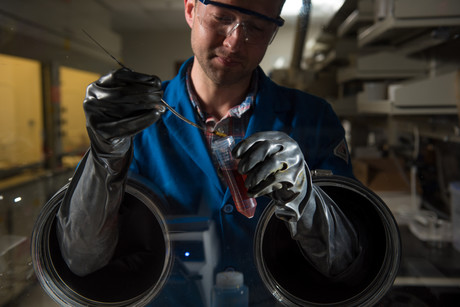Pharmaceutical material could be deployed in batteries

Scientists in the US have developed a highly reversible, water-soluble material based on phenazine, an organic molecule used in dyes and antibiotics. The compound could potentially serve as an alternative to vanadium, which is used in grid-scale batteries to store electricity.
Supported by the Department of Energy’s Office of Electricity, researchers at Pacific Northwest National Laboratory (PNNL) developed their new material in an effort to reduce the cost of redox flow batteries, many of which use a vanadium-based electrolyte. Vanadium is primarily used in steelmaking and, as a commodity material, its costs can vary based on supply and demand.
The PNNL research team, led by Chief Scientist Wei Wang, knew that phenazine, a naturally occurring compound, possesses the required redox reactions but was not water soluble. So the team developed a method of chemically modifying phenazine, producing a water-soluble derivative that also optimises its redox properties. When dissolved in the electrolyte solution, the team found 90% of the dissolved phenazine available to carry energy.
“This is a major development for organic flow batteries,” said Imre Gyuk, Director of Energy Storage at the Office of Electricity. “There is much interest around the potential for water-soluble, organic redox materials as an alternative to vanadium-based batteries. However, the problem is getting the materials to actually dissolve in water and maintain the desired electrochemical properties.”
According to Wang, modifying the phenazine is straightforward and scalable. And while the team still needs to conduct a cost analysis, phenazine precursor chemicals are readily available and inexpensive.
“The results are promising,” said Wang. “We have not only developed a viable alternative to vanadium, we have developed a structured, virtual screening approach that will help us identify new promising materials.”
With their research now published in the journal Nature Energy, PNNL will continue testing a phenazine-based anolyte (negative electrolyte) and plans to develop a corresponding catholyte (positive electrolyte). Combined, the solutions could lead to a new type of redox flow battery.
Originally published here.
Predictive AI model enhances solid-state battery design
ECU researchers are working on ways to make solid-state batteries more reliable with the help of...
Boosting performance of aqueous zinc–iodine batteries
Engineers from the University of Adelaide have enhanced aqueous zinc–iodine batteries using...
Sodium-ion battery breakthrough boosts energy storage
Scientists have discovered that leaving water inside a key material, rather than removing it,...




